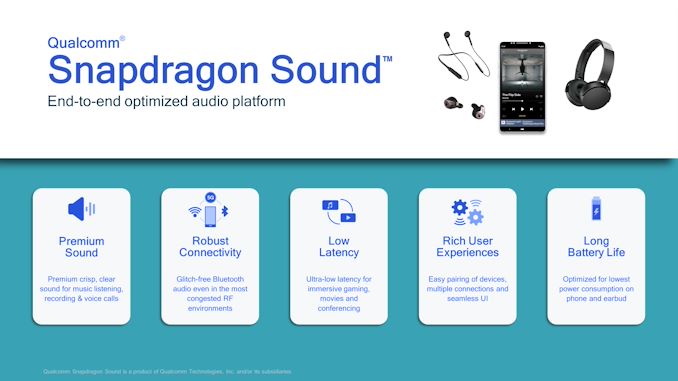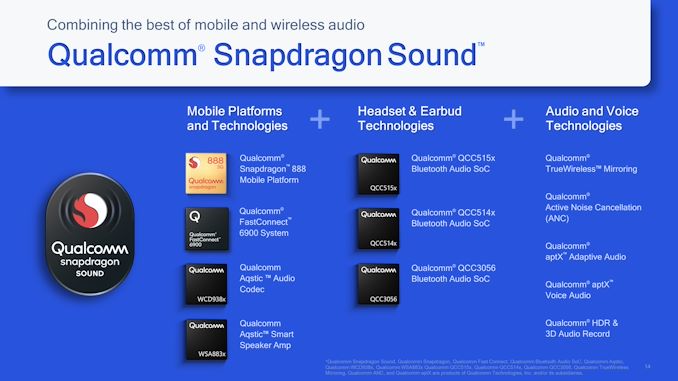Qualcomm Announces "Snapdragon Sound" Initiative
by Andrei Frumusanu on March 4, 2021 11:00 AM EST- Posted in
- Mobile
- Audio
- Qualcomm
- Smartphones

Today Qualcomm is announcing the new “Snapdragon Sound” branding initiative, essentially an umbrella term that covers the company’s various audio related hardware and software products, promising improved end-to-end interoperability for a better audio experience.
Qualcomm’s initiative is rather vague, but it appears to be to be focused on a certification program that ensures correctly engineered software stacks between a phone’s audio subsystem and the listening device. Qualcomm here particularly looks to focus on wireless audio technologies with greater audio fidelity, most of the technologies surrounding Qualcomm’s proprietary aptX codec and its derivatives. At least one concrete example of an optimised Snapdragon Sound system is Bluetooth audio latency, which would reach down to 89ms in the company’s example.
On the hardware side of things, mobile platforms obviously cover Qualcomm’s Aqstic audio codec chips as well as speaker amplifiers, but extends the umbrella out to the company’s Bluetooth audio SoCs which are popular amongst wireless headphone manufacturers.
It’s not clear if the end-to-end optimisations are solely limited to Qualcomm hardware products, or if third-party audio hardware solutions will also gain benefit of the optimised audio stack.
Qualcomm states that the first devices supporting Snapdragon Sound optimisations are expected to be available later this year.












41 Comments
View All Comments
ZolaIII - Wednesday, March 10, 2021 - link
Well 99% of available material are in 16 bit (true) form. 44100 Hz 16 bit full dynamic range is 96 dB while dynamic range contained in recorded music is usually far less (with some novel examples in complex philharmonic classical peaces and eventually some Dolby not music recordings). Arguably there's benefit in very rare situations (recordings) end even that with great hedaphones with corresponding LPS and for shot analytical listening on such high volume levels. How ever there are benefits of even using 32 bit floating precision in some losy formats such as Opus but that's related how they actually work. I clearly stated how there are some benefits of using higher sampling rates (pushing introduced noise to where you cannot hear it, it's legit method of lovering it in the area where you can). Would be nice for those interested in the topic to read how Opus actually works.Wereweeb - Thursday, March 4, 2021 - link
Glad to see this kind of initiative. Maybe one day, combined with some novel battery technology, we'll see good wireless earphones. Until then, I'll keep telling people to buy Moondrop's Starfield.ZolaIII - Friday, March 5, 2021 - link
More snake oil and doungrades incoming.JoeDuarte - Monday, March 8, 2021 - link
"...but it appears to be to be focused on a certification program..."Fix your typos AnandTech. It's incredibly unprofessional for you guys to have typos like this in every article you publish. Hire someone. Use normal word processing software instead of Markdown. Whatever you need to do.
keremutku - Sunday, March 14, 2021 - link
Sitemizi ziyaret edebilirsiniz. https://www.viltrin.com/keremutku - Sunday, March 14, 2021 - link
Sitemizi ziyaret edebilirsiniz. https://www.viltrin.com/keremutku - Sunday, March 14, 2021 - link
Sitemizi ziyaret edebilirsiniz. https://nors.com.tr/keremutku - Sunday, March 14, 2021 - link
Sitemizi ziyaret edebilirsiniz. https://nors.com.tr/keremutku - Sunday, March 14, 2021 - link
Sitemizi ziyaret edebilirsiniz. https://www.ecefermuar.com.tr/